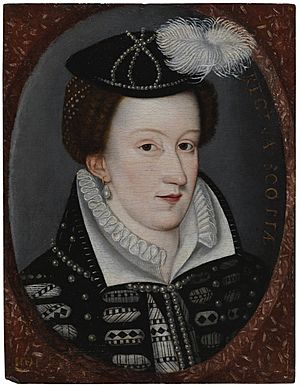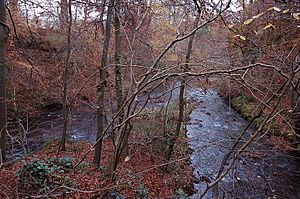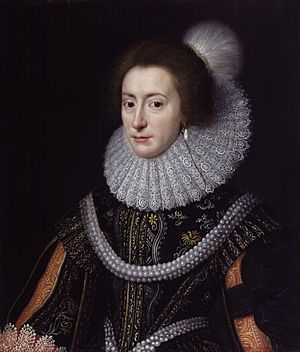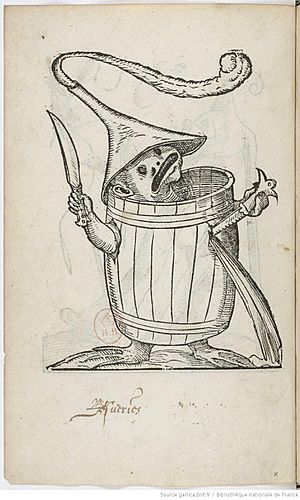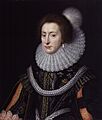Nicolas Elphinstone facts for kids
Nicolas Elphinstone (died 1579) was an important helper and messenger for the Scottish government. He worked for James Stewart, who was the Regent of Scotland. A Regent is someone who rules a country when the king or queen is too young or unable to rule.
Elphinstone was involved in trying to sell the valuable jewels and pearls that belonged to Mary, Queen of Scots. This happened in 1567 and 1568. Regent Moray needed to raise money to run Scotland and to deal with Mary's supporters.
Contents
Elphinstone's Home at Schank
On August 1, 1566, Nicolas Elphinstone gained control of the lands of Schank. This area was north of the Arniston estate in Midlothian, Scotland. A picture of the house at Schank was drawn on an old map from the 1500s.
Today, you can still see the old walled garden of a later house in the area. It is located at Gore Glen Woodland Park. This park is on the higher ground between the South Esk and the Gore Water rivers. The wooded area between these rivers is sometimes called the "Shank Tongue."
Elphinstone's Missions to London
Nicolas Elphinstone was trained in law and was a key helper for James Stewart, the Earl of Moray. Moray was the half-brother of Mary, Queen of Scots.
In the summer of 1565, Moray sent Elphinstone to the court of Queen Elizabeth I in England. A writer named John Knox said Elphinstone went to England in July 1565. His goal was to get money for Mary's political opponents. This was around the time Mary married Lord Darnley. The money was for a rebellion known as the Chaseabout Raid.
On August 2, 1565, Moray wrote to the Earl of Bedford, who was in charge of Berwick. Moray said he had sent a boat to Lindisfarne to pick up Elphinstone. He hoped Elphinstone would have a safe journey on land from Newcastle. The boat was also meant to take Moray's pregnant wife, Agnes Keith, to the English court in September.
Mary Queen of Scots was later held prisoner in Lochleven Castle. This happened after the battle of Carberry Hill. The Earl of Moray was in London at the time. He sent Nicolas Elphinstone to Mary in July 1567. However, the Scottish lords who held Mary would not let Elphinstone see her. The lords thought about sending Elphinstone to France. There, he would explain their actions to King Charles IX. Moray arrived back in Scotland and became the Regent of Scotland on August 22, 1567. He now controlled royal property, including a chest of jewels in Edinburgh Castle.
On October 20, 1567, Regent Moray sent Elphinstone to Berwick-upon-Tweed and London. Elphinstone carried some of the queen's jewels. These jewels were meant to be sold to raise money, not just used as a guarantee for loans. They were thought to be worth about 9,000 French crowns.
The jewels included:
- A chain with 91 small rings and small rubies. It also had 12 square parts with diamonds and one round part with a ruby. This was valued at 3,000 French crowns.
- Four large rubies set in a gold head-dress. Valued at 3,000 French crowns.
- Four large diamonds set in the same way. Valued at 3,000 French crowns.
Selling Pearls to Queen Elizabeth
Elphinstone sold a large collection of pearls to Queen Elizabeth at the end of April 1568. These pearls are now known as the "Medici pearls." It is said that Pope Clement VII gave them as a wedding gift to Catherine de' Medici. A writer named Brantôme wrote that Catherine gave them to Mary, Queen of Scots. He also saw Mary wearing them. Catherine later tried to buy them back when they were in London.
These pearls are believed to have been given to Princess Elizabeth in 1613 when she got married. Some of them are thought to have returned to the British royal family. King James bought pearls and gave them to Princess Elizabeth before her marriage. In 1619, Anne of Denmark had a necklace of long and round pearls. It was worth £40,000 and was said to be the "fairest that are to be found in Christendom."
We know about the attempts to sell the jewels in London in 1568 from the letters of a French diplomat named Jacques Bochetel de la Forest. Bochetel described the large pearls in great detail. There were six strings of pearls, each with twenty-five pearls. Many of them were large and beautiful, "as big as muscady nuts." Several merchants valued them for Queen Elizabeth. English merchants offered 10,000 crowns, Italians offered 12,000, and a merchant from Geneva suggested 16,000. It is thought that Elizabeth paid 12,000 crowns. The other jewels offered were not as valuable, except for a piece of unicorn horn. There were no black pearls.
Bochetel de Forrest also wrote that Elphinstone met a Scottish double-agent named Ninian Cockburn in Berwick. Nicholas Throckmorton helped Elphinstone get a meeting with Queen Elizabeth. Elphinstone showed her the jewels and pearls. The Earls of Pembroke and Leicester were also there. Bochetel wrote that the jewels were brought secretly to London. The pearls were sold to Elizabeth for twelve thousand crowns.
The sale was not kept secret for long. When Elphinstone arrived in Carlisle in June 1568, Mary asked for his arrest. She called him "hyr grevous enemye and seller of hyr juells" (her terrible enemy and seller of her jewels). William Kirkcaldy of Grange also mentioned the sale. He wrote that Mr. Nicolas Elphinstone sold the pearls in London for 13,000 or 14,000. He noted that the Queen of England bought them for herself.
The jewel sales stopped when Mary escaped from Lochleven and arrived in England on May 16, 1568. Queen Elizabeth then had to appear neutral in Scottish affairs. She stopped buying jewels directly from Moray's agents. She also tried to stop other sales of Mary's belongings in England. Elphinstone sent a letter to William Cecil when he returned to Edinburgh on May 21, 1568. The letter was carried by a man who had been at the battle of Langside. This man could describe the battle to Cecil.
Elphinstone as Regent Moray's Messenger
Elphinstone continued to deliver messages to Queen Elizabeth and William Cecil for Regent Moray. In June 1568, he took Moray's message to Lord Scrope at Carlisle.
Moray gave Elphinstone black velvet for clothes and 120 French gold crowns. This was for a trip to London in January 1570. Elphinstone's job was to discuss plans for William Drury, the Marshal of Berwick. Drury might lead an army in Scotland against Mary's supporters. Elphinstone also discussed issues after the Rising of the North rebellion. He also talked about Moray's actions against his own rebels. Elphinstone was to ask for at least £1,000 and £1,000 yearly to protect Protestant Scotland. John Tamworth, who managed Elizabeth's money, had loaned Moray £5,000. Later, there was some doubt about whether Elizabeth would pay Moray regularly. Elizabeth sent Thomas Randolph to Scotland to answer Moray's requests. However, Moray had been assassinated before Randolph arrived.
Mary heard that Elphinstone had arrived in London. She believed he was working to have her sent back to Scotland as a prisoner. On January 24, 1570, she wrote from Tutbury Castle: "we remain still in great pain to understand what way of practise Elphinstone can make at court for our delivering in Murray's hands." Regent Moray had already been shot in Linlithgow by James Hamilton of Bothwellhaugh. Elphinstone was in London when the news of the assassination broke. He thought the story was false, a rumor spread by Mary's secretary, the Bishop of Ross. He wrote to Cecil with this idea. The jewels that had not been sold were left with Regent Moray's widow, Agnes Keith.
Later that year, Elphinstone received instructions from Regent Lennox. He had 34 points to discuss with the Earl of Sussex. He rode to Alnwick with the Earl's servant on October 26, 1570. This mission was to convince Sussex that Mary's supporters had broken a truce. Sussex wanted the truce to continue.
In June 1572, he delivered letters to Queen Elizabeth from Regent Mar. At that time, Elizabeth was busy with French ambassadors. Thomas Randolph wrote to Mar that Elphinstone was returning with disappointing news. Elphinstone received £50 yearly from the English treasury. This was a payment for people who supported England's policies in Scotland. He was described as a good helper to the late Regent Moray. He was also seen as wise and supportive of England. He was also well-liked by Regent Morton.
Working for Regent Morton
In January 1573, Elphinstone wrote to the English ambassador Henry Killigrew. He described events during the siege of Edinburgh Castle. He noted that the castle defenders were using a well near St Cuthbert's kirk. He also asked for money for the Regent's soldiers. Killigrew sent his letter on to William Cecil.
By September 1576, Elphinstone owned the property of Schank in East Lothian. Regent Morton arranged a special gift for him. It was a yearly payment of £200 from certain church funds. The gift letter stated that Elphinstone had served King James VI "since his nativity." This was especially true in important matters outside Scotland. Elphinstone complained in 1577 that he had not received payments from the lands of Newbattle Abbey. During a border problem known as the Raid of the Redeswire in 1577, Morton thought about sending Elphinstone to Queen Elizabeth. However, her ambassador Henry Killigrew arrived in Edinburgh first.
Elphinstone brought two books for the young king's library. One was an illustrated book about different costumes. The other was a French comic book called Les songes drolatiques de Pantagruel (Paris 1565). In 1577, Elphinstone told Regent Morton that the people looking after the young king at Stirling Castle were not loyal to him. According to James Melville of Halhill, Elphinstone advised Morton to pay them to gain their loyalty.
Nicolas Elphinstone had passed away before February 1579. At that time, his family received £1,461 Scots from the royal mint.
Shank Place and Its History
The lands of Shank were passed down to Nicolas Elphinstone's son, John Elphinstone. His widow, Elizabeth Edmonstoun, also held the land. The Elphinstones traded some land with George Dundas of Arniston. A disagreement over the border of their lands led to one of the earliest estate maps in Scotland being made in 1582. This map included a picture of "Schanck Place."
The map shows a rectangular walled garden north of the house. It also shows a road leading south towards Arniston Mains. Shank Place was drawn as a tower house with a roof at four levels. It had a single-story wall or courtyard running west to a narrow tower with a pointed roof. This tower looked like the Glassin tower at Lochleven Castle, where Mary, Queen of Scots had been held prisoner. This building was later taken down and replaced by another house.
In 1617, a man named William Franshe complained to the Privy Council. He said that two young women, who were his relatives, had been kept prisoner at Schank for six years. They were "kept away from all society." Their brother had died in 1617 after being taken from school and forced to marry in 1613. William French worried that the two sisters might also be forced to marry against his wishes. John Elphinstone of Schank was ordered to give the girls to the care of the Privy Council. One sister later married John Cranston, and the other married another member of the Cranstoun family.
The ownership of Shank eventually went to George Mackenzie of Rosehaugh. His family later sold it to Robert Dundas in 1753.
Images for kids
-
Confluence of the Gore and South Esk, on the former Elphinstone Schank property


